air condition TOYOTA AURIS 2018 Owners Manual (in English)
[x] Cancel search | Manufacturer: TOYOTA, Model Year: 2018, Model line: AURIS, Model: TOYOTA AURIS 2018Pages: 592, PDF Size: 28.6 MB
Page 5 of 592
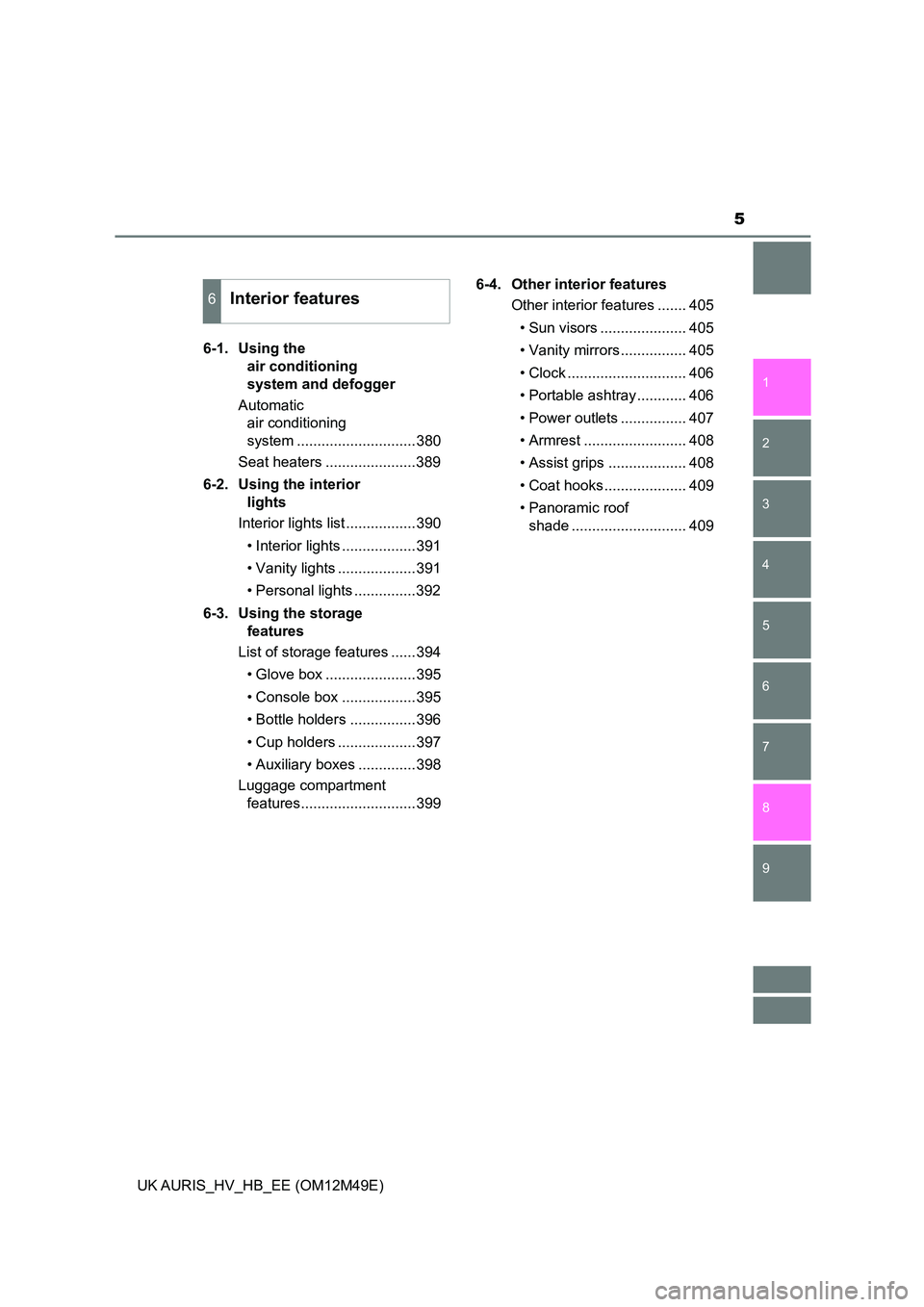
5
1
9
8
7
5
4
3
2
UK AURIS_HV_HB_EE (OM12M49E)
6
6-1. Using the
air conditioning
system and defogger
Automatic
air conditioning
system .............................380
Seat heaters ......................389
6-2. Using the interior
lights
Interior lights list .................390
• Interior lights ..................391
• Vanity lights ...................391
• Personal lights ...............392
6-3. Using the storage
features
List of storage features ......394
• Glove box ......................395
• Console box ..................395
• Bottle holders ................396
• Cup holders ...................397
• Auxiliary boxes ..............398
Luggage compartment
features............................399
6-4. Other interior features
Other interior features ....... 405
• Sun visors ..................... 405
• Vanity mirrors ................ 405
• Clock ............................. 406
• Portable ashtray ............ 406
• Power outlets ................ 407
• Armrest ......................... 408
• Assist grips ................... 408
• Coat hooks .................... 409
• Panoramic roof
shade ............................ 409
6Interior features
Page 6 of 592

TABLE OF CONTENTS6
UK AURIS_HV_HB_EE (OM12M49E)
7-1. Maintenance and care
Cleaning and protecting
the vehicle exterior ..........412
Cleaning and protecting
the vehicle interior ...........416
7-2. Maintenance
Maintenance
requirements....................419
7-3. Do-it-yourself
maintenance
Do-it-yourself service
precautions ......................422
Hood ..................................424
Positioning a floor jack .......426
Engine compartment..........427
12-volt battery ....................434
Tires ...................................439
Tire inflation pressure ........453
Wheels ...............................455
Air conditioning filter ..........457
Electronic key battery ........459
Checking and replacing
fuses ................................462
Light bulbs .........................467
8-1. Essential information
Emergency flashers .......... 482
If your vehicle has
to be stopped
in an emergency ............. 483
8-2. Steps to take
in an emergency
If your vehicle needs
to be towed ..................... 484
If you think something
is wrong........................... 490
If a warning light turns on
or a warning buzzer
sounds ............................ 491
If a warning message
is displayed ..................... 498
If you have a flat tire
(vehicles with
a spare tire) ..................... 507
If you have a flat tire
(vehicles with
an emergency tire
puncture repair kit) .......... 519
If the hybrid system will
not start ........................... 534
If the electronic key
does not operate
properly ........................... 536
If the 12-volt battery
is discharged ................... 539
If your vehicle
overheats ........................ 544
If the vehicle becomes
stuck................................ 549
7Maintenance and care8When trouble arises
Page 17 of 592
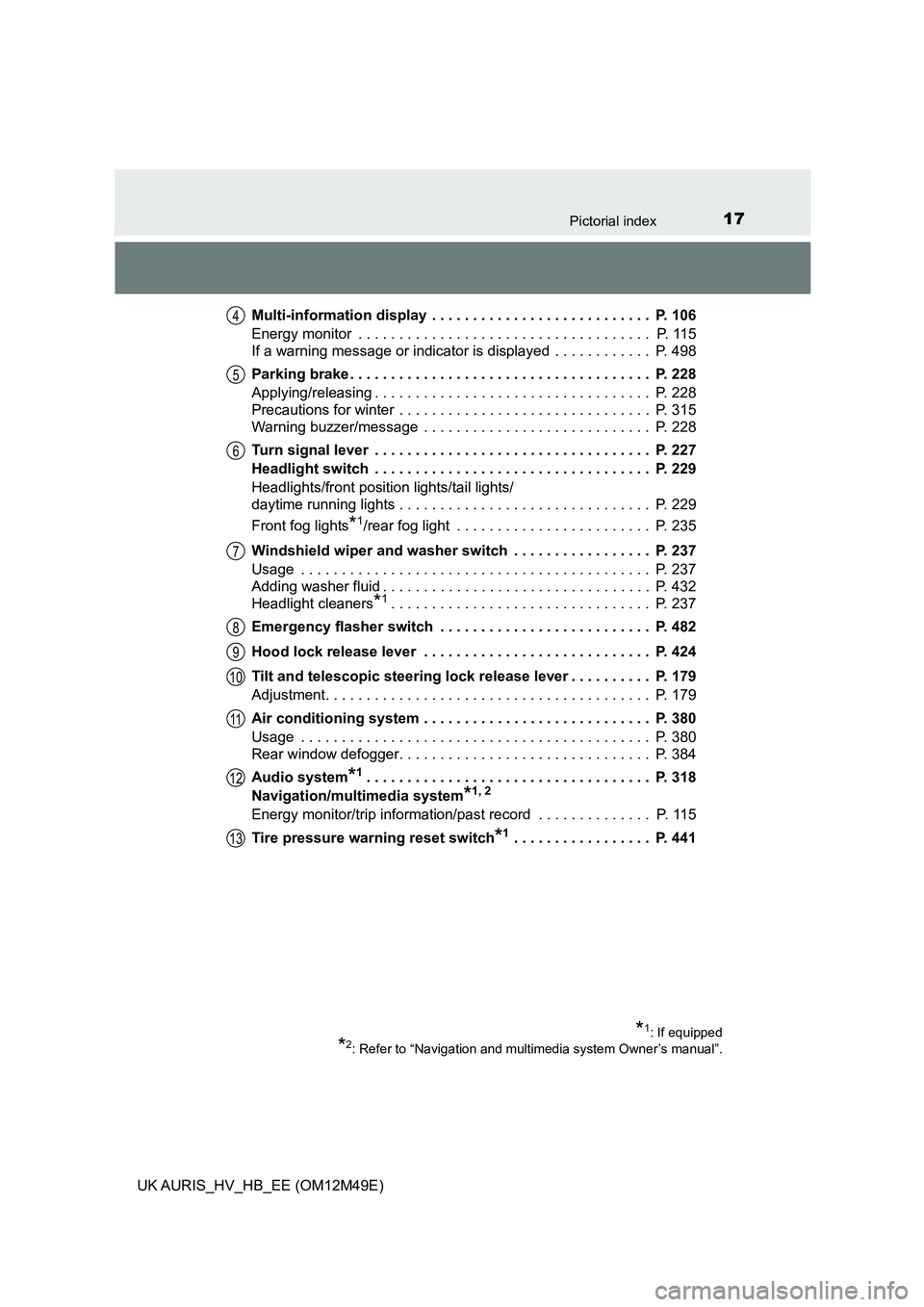
17Pictorial index
UK AURIS_HV_HB_EE (OM12M49E)
Multi-information display . . . . . . . . . . . . . . . . . . . . . . . . . . . P. 106
Energy monitor . . . . . . . . . . . . . . . . . . . . . . . . . . . . . . . . . . . . P. 115
If a warning message or indicator is displayed . . . . . . . . . . . . P. 498
Parking brake . . . . . . . . . . . . . . . . . . . . . . . . . . . . . . . . . . . . . P. 228
Applying/releasing . . . . . . . . . . . . . . . . . . . . . . . . . . . . . . . . . . P. 228
Precautions for winter . . . . . . . . . . . . . . . . . . . . . . . . . . . . . . . P. 315
Warning buzzer/message . . . . . . . . . . . . . . . . . . . . . . . . . . . . P. 228
Turn signal lever . . . . . . . . . . . . . . . . . . . . . . . . . . . . . . . . . . P. 227
Headlight switch . . . . . . . . . . . . . . . . . . . . . . . . . . . . . . . . . . P. 229
Headlights/front position lights/tail lights/
daytime running lights . . . . . . . . . . . . . . . . . . . . . . . . . . . . . . . P. 229
Front fog lights*1/rear fog light . . . . . . . . . . . . . . . . . . . . . . . . P. 235
Windshield wiper and washer switch . . . . . . . . . . . . . . . . . P. 237
Usage . . . . . . . . . . . . . . . . . . . . . . . . . . . . . . . . . . . . . . . . . . . P. 237
Adding washer fluid . . . . . . . . . . . . . . . . . . . . . . . . . . . . . . . . . P. 432
Headlight cleaners*1. . . . . . . . . . . . . . . . . . . . . . . . . . . . . . . . P. 237
Emergency flasher switch . . . . . . . . . . . . . . . . . . . . . . . . . . P. 482
Hood lock release lever . . . . . . . . . . . . . . . . . . . . . . . . . . . . P. 424
Tilt and telescopic steering lock release lever . . . . . . . . . . P. 179
Adjustment. . . . . . . . . . . . . . . . . . . . . . . . . . . . . . . . . . . . . . . . P. 179
Air conditioning system . . . . . . . . . . . . . . . . . . . . . . . . . . . . P. 380
Usage . . . . . . . . . . . . . . . . . . . . . . . . . . . . . . . . . . . . . . . . . . . P. 380
Rear window defogger. . . . . . . . . . . . . . . . . . . . . . . . . . . . . . . P. 384
Audio system*1. . . . . . . . . . . . . . . . . . . . . . . . . . . . . . . . . . . P. 318
Navigation/multimedia system*1, 2
Energy monitor/trip information/past record . . . . . . . . . . . . . . P. 115
Tire pressure warning reset switch*1 . . . . . . . . . . . . . . . . . P. 441
4
5
6
7
8
9
10
11
12
13
*1: If equipped
*2: Refer to “Navigation and multimedia system Owner’s manual”.
Page 23 of 592
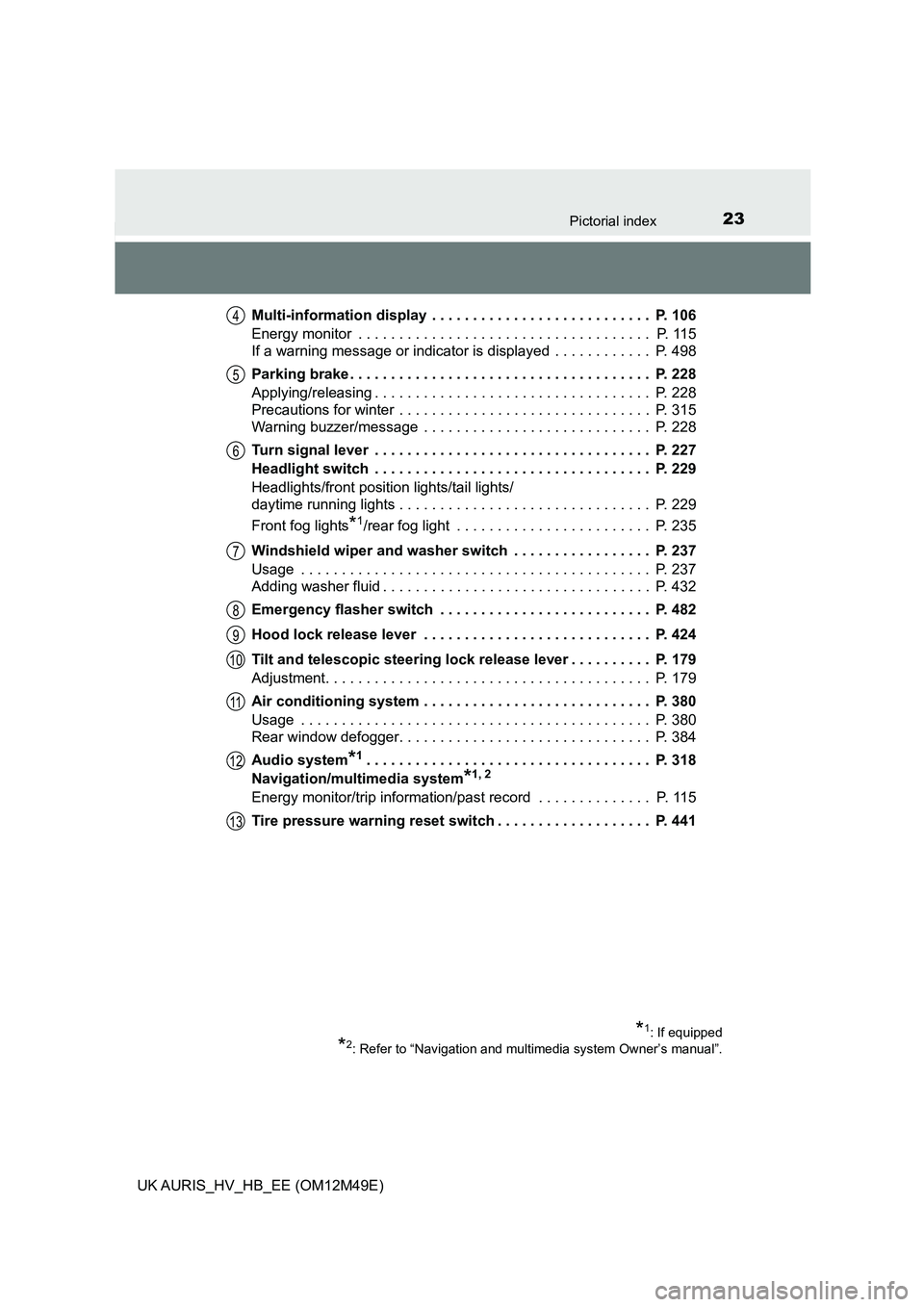
23Pictorial index
UK AURIS_HV_HB_EE (OM12M49E)
Multi-information display . . . . . . . . . . . . . . . . . . . . . . . . . . . P. 106
Energy monitor . . . . . . . . . . . . . . . . . . . . . . . . . . . . . . . . . . . . P. 115
If a warning message or indicator is displayed . . . . . . . . . . . . P. 498
Parking brake . . . . . . . . . . . . . . . . . . . . . . . . . . . . . . . . . . . . . P. 228
Applying/releasing . . . . . . . . . . . . . . . . . . . . . . . . . . . . . . . . . . P. 228
Precautions for winter . . . . . . . . . . . . . . . . . . . . . . . . . . . . . . . P. 315
Warning buzzer/message . . . . . . . . . . . . . . . . . . . . . . . . . . . . P. 228
Turn signal lever . . . . . . . . . . . . . . . . . . . . . . . . . . . . . . . . . . P. 227
Headlight switch . . . . . . . . . . . . . . . . . . . . . . . . . . . . . . . . . . P. 229
Headlights/front position lights/tail lights/
daytime running lights . . . . . . . . . . . . . . . . . . . . . . . . . . . . . . . P. 229
Front fog lights*1/rear fog light . . . . . . . . . . . . . . . . . . . . . . . . P. 235
Windshield wiper and washer switch . . . . . . . . . . . . . . . . . P. 237
Usage . . . . . . . . . . . . . . . . . . . . . . . . . . . . . . . . . . . . . . . . . . . P. 237
Adding washer fluid . . . . . . . . . . . . . . . . . . . . . . . . . . . . . . . . . P. 432
Emergency flasher switch . . . . . . . . . . . . . . . . . . . . . . . . . . P. 482
Hood lock release lever . . . . . . . . . . . . . . . . . . . . . . . . . . . . P. 424
Tilt and telescopic steering lock release lever . . . . . . . . . . P. 179
Adjustment. . . . . . . . . . . . . . . . . . . . . . . . . . . . . . . . . . . . . . . . P. 179
Air conditioning system . . . . . . . . . . . . . . . . . . . . . . . . . . . . P. 380
Usage . . . . . . . . . . . . . . . . . . . . . . . . . . . . . . . . . . . . . . . . . . . P. 380
Rear window defogger. . . . . . . . . . . . . . . . . . . . . . . . . . . . . . . P. 384
Audio system*1. . . . . . . . . . . . . . . . . . . . . . . . . . . . . . . . . . . P. 318
Navigation/multimedia system*1, 2
Energy monitor/trip information/past record . . . . . . . . . . . . . . P. 115
Tire pressure warning reset switch . . . . . . . . . . . . . . . . . . . P. 441
4
5
6
7
8
9
10
11
12
13
*1: If equipped
*2: Refer to “Navigation and multimedia system Owner’s manual”.
Page 44 of 592
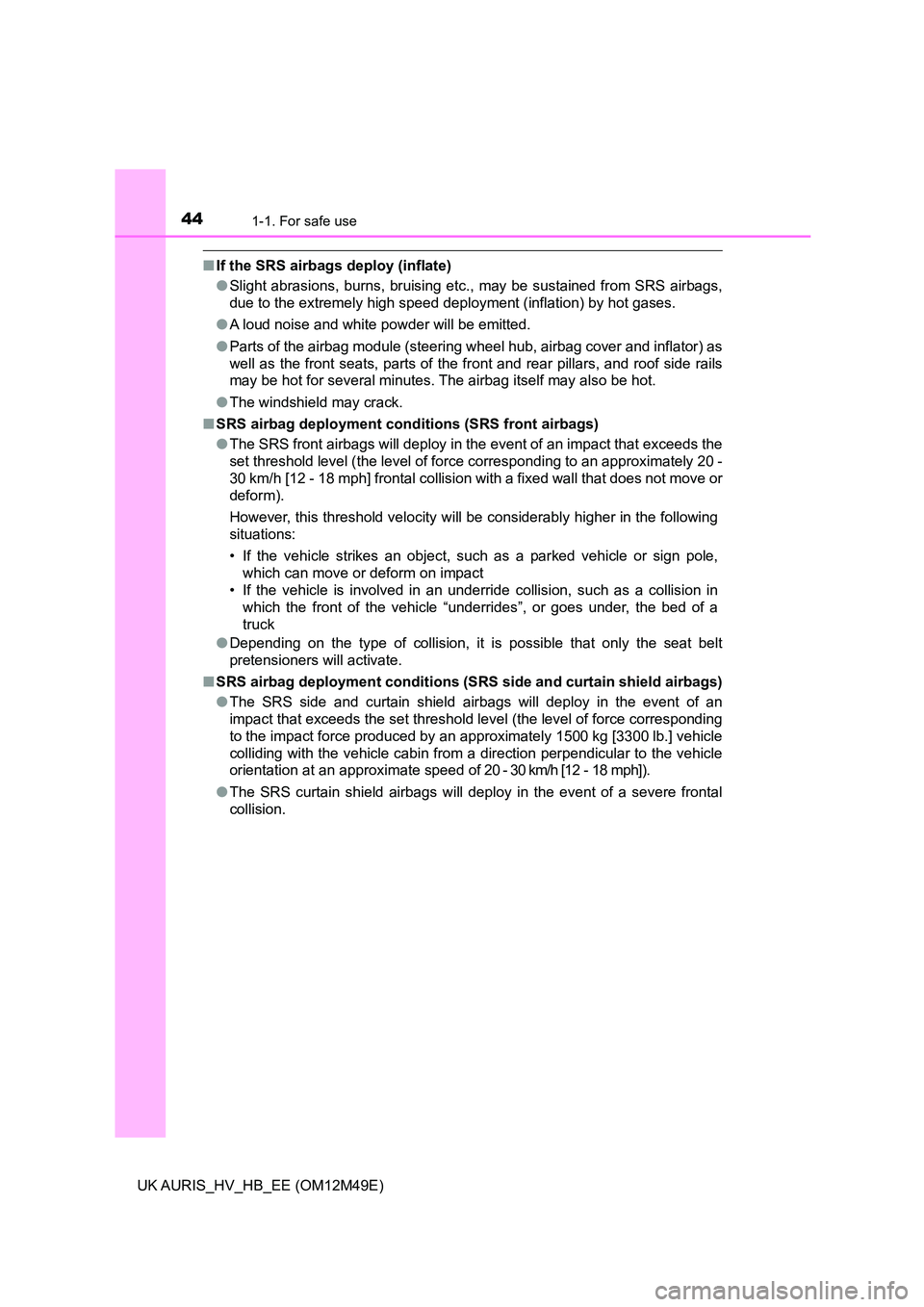
441-1. For safe use
UK AURIS_HV_HB_EE (OM12M49E)
■If the SRS airbags deploy (inflate)
● Slight abrasions, burns, bruising etc., may be sustained from SRS airbags,
due to the extremely high speed deployment (inflation) by hot gases.
● A loud noise and white powder will be emitted.
● Parts of the airbag module (steering wheel hub, airbag cover and inflator) as
well as the front seats, parts of the front and rear pillars, and roof side rails
may be hot for several minutes. The airbag itself may also be hot.
● The windshield may crack.
■ SRS airbag deployment conditions (SRS front airbags)
● The SRS front airbags will deploy in the event of an impact that exceeds the
set threshold level (the level of fo rce corresponding to an approximately 20 -
30 km/h [12 - 18 mph] frontal collision with a fixed wall that does not move or
deform).
However, this threshold velocity will be considerably higher in the following
situations:
• If the vehicle strikes an object, such as a parked vehicle or sign pole,
which can move or deform on impact
• If the vehicle is involved in an underride collision, such as a collision in
which the front of the vehicle “underrides”, or goes under, the bed of a
truck
● Depending on the type of collision, it is possible that only the seat belt
pretensioners will activate.
■ SRS airbag deployment conditions (SRS side and curtain shield airbags)
● The SRS side and curtain shield airbags will deploy in the event of an
impact that exceeds the set threshold level (the level of force corresponding
to the impact force produced by an approximately 1500 kg [3300 lb.] vehicle
colliding with the vehicle cabin from a direction perpendicular to the vehicle
orientation at an approximate speed of 20 - 30 km/h [12 - 18 mph]).
● The SRS curtain shield airbags will deploy in the event of a severe frontal
collision.
Page 45 of 592
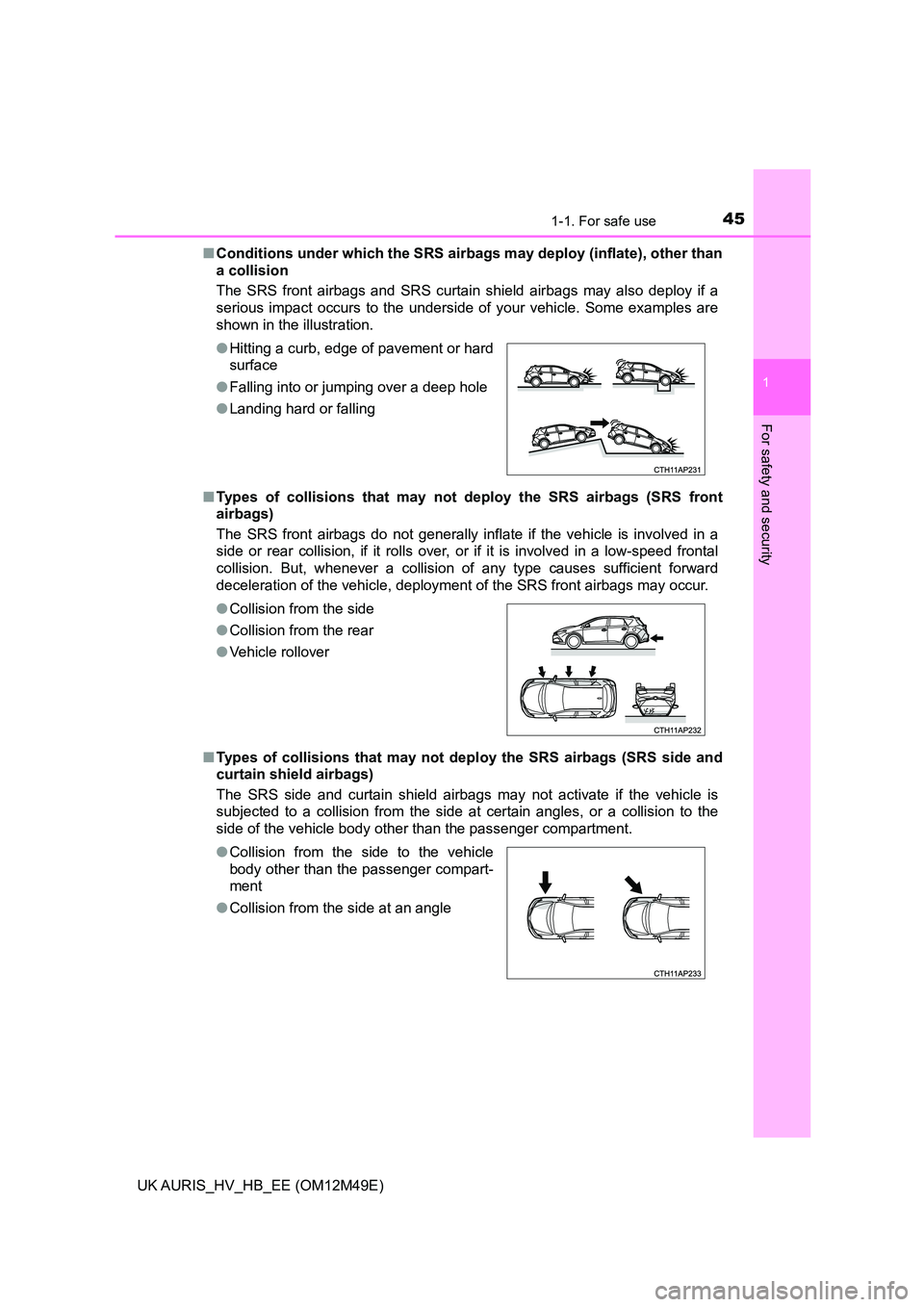
451-1. For safe use
1
For safety and security
UK AURIS_HV_HB_EE (OM12M49E)
■ Conditions under which the SRS airbags may deploy (inflate), other than
a collision
The SRS front airbags and SRS curtain shield airbags may also deploy if a
serious impact occurs to the underside of your vehicle. Some examples are
shown in the illustration.
■ Types of collisions that may not deploy the SRS airbags (SRS front
airbags)
The SRS front airbags do not generally inflate if the vehicle is involved in a
side or rear collision, if it rolls over, or if it is involved in a low-speed frontal
collision. But, whenever a collision of any type causes sufficient forward
deceleration of the vehicle, deployment of the SRS front airbags may occur.
■ Types of collisions that may not deploy the SRS airbags (SRS side and
curtain shield airbags)
The SRS side and curtain shield airbags may not activate if the vehicle is
subjected to a collision from the side at certain angles, or a collision to the
side of the vehicle body other than the passenger compartment.
● Hitting a curb, edge of pavement or hard
surface
● Falling into or jumping over a deep hole
● Landing hard or falling
● Collision from the side
● Collision from the rear
● Vehicle rollover
● Collision from the side to the vehicle
body other than the passenger compart-
ment
● Collision from the side at an angle
Page 73 of 592
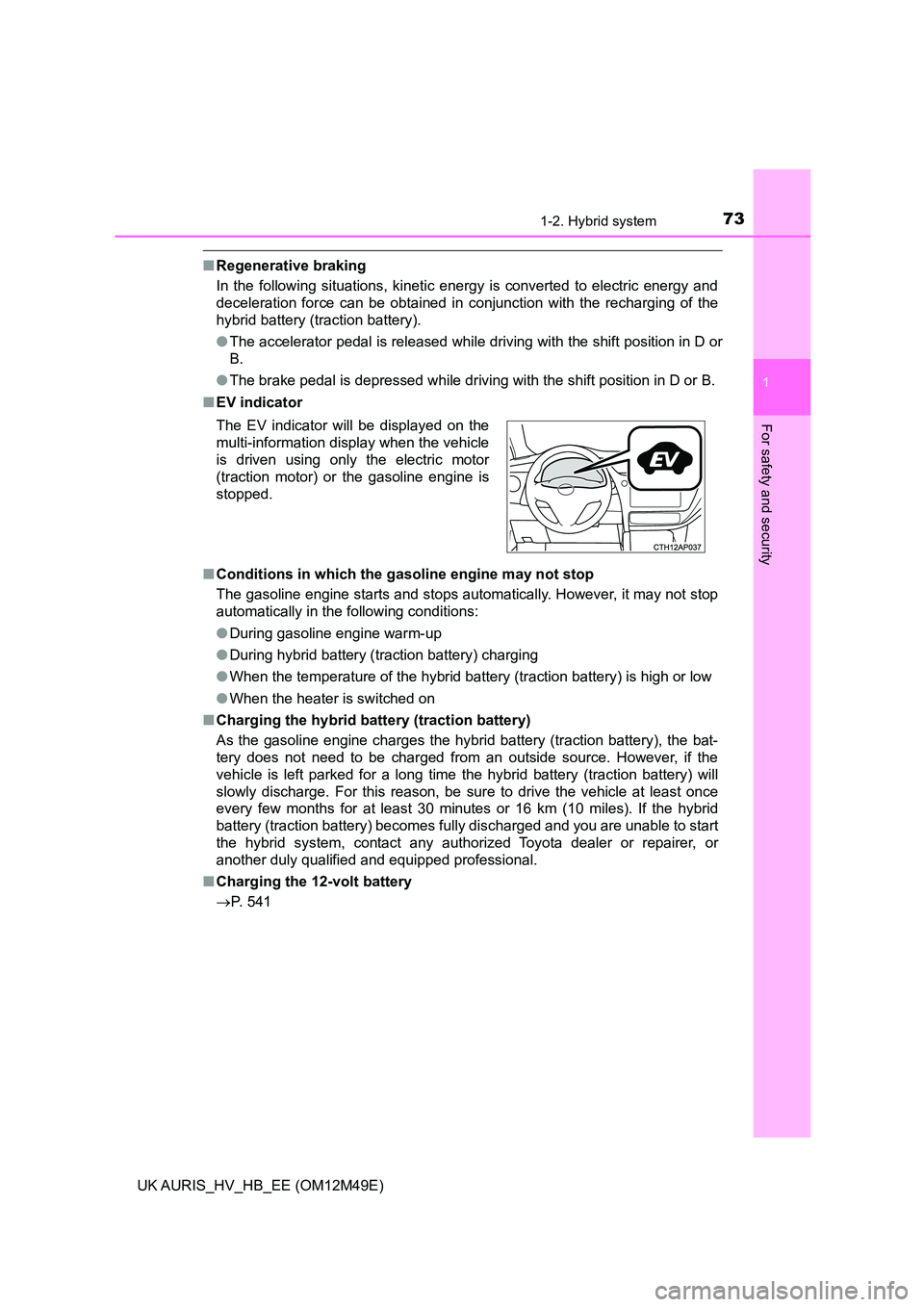
731-2. Hybrid system
1
For safety and security
UK AURIS_HV_HB_EE (OM12M49E)
■Regenerative braking
In the following situations, kinetic energy is converted to electric energy and
deceleration force can be obtained in conjunction with the recharging of the
hybrid battery (traction battery).
● The accelerator pedal is released while driving with the shift position in D or
B.
● The brake pedal is depressed while driving with the shift position in D or B.
■ EV indicator
■ Conditions in which the gasoline engine may not stop
The gasoline engine starts and stops automatically. However, it may not stop
automatically in the following conditions:
● During gasoline engine warm-up
● During hybrid battery (traction battery) charging
● When the temperature of the hybrid battery (traction battery) is high or low
● When the heater is switched on
■ Charging the hybrid battery (traction battery)
As the gasoline engine charges the hybrid battery (traction battery), the bat-
tery does not need to be charged from an outside source. However, if the
vehicle is left parked for a long time the hybrid battery (traction battery) will
slowly discharge. For this reason, be sure to drive the vehicle at least once
every few months for at least 30 minutes or 16 km (10 miles). If the hybrid
battery (traction battery) becomes fully discharged and you are unable to start
the hybrid system, contact any authorized Toyota dealer or repairer, or
another duly qualified and equipped professional.
■ Charging the 12-volt battery
P. 541
The EV indicator will be displayed on the
multi-information display when the vehicle
is driven using only the electric motor
(traction motor) or the gasoline engine is
stopped.
Page 75 of 592
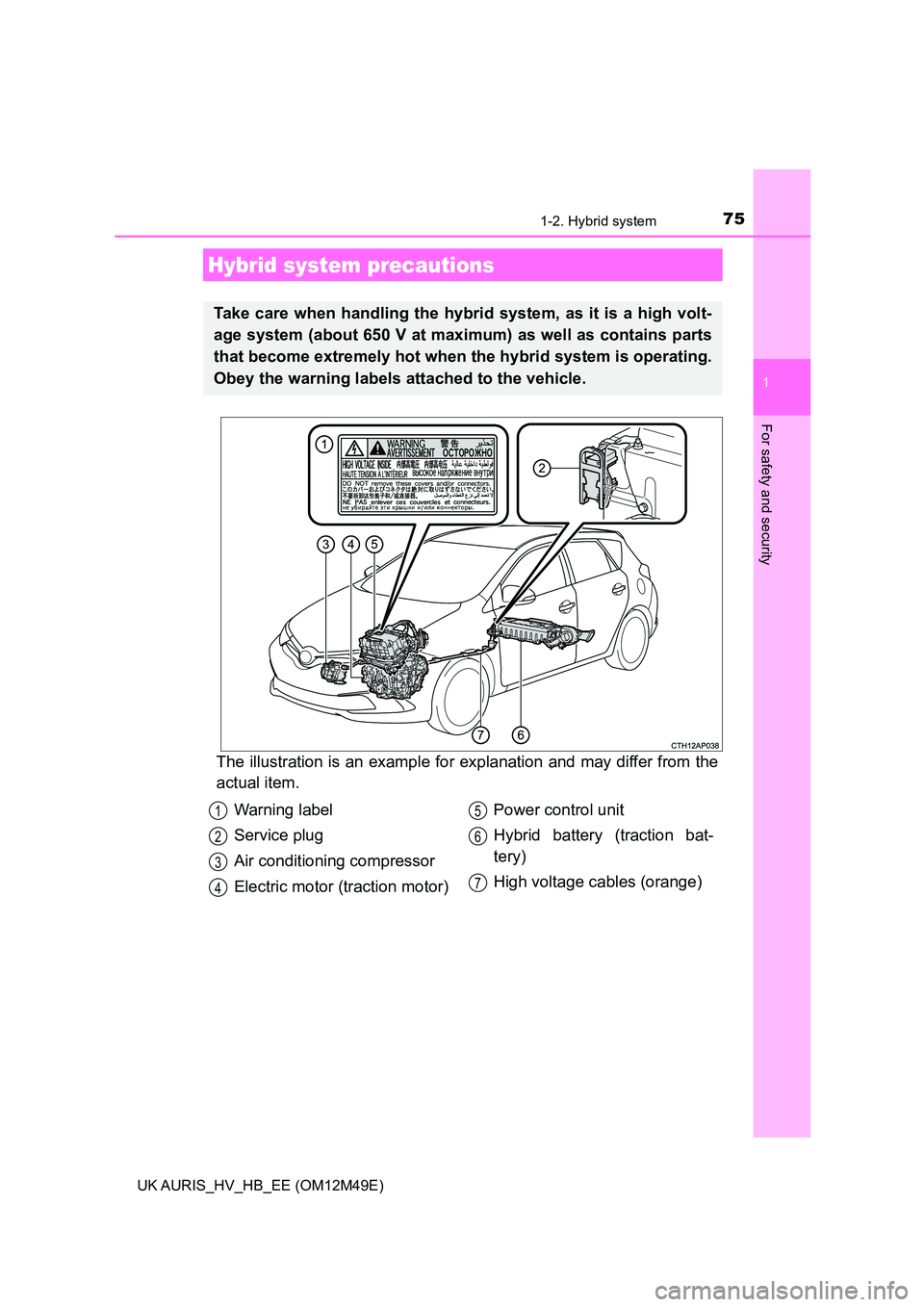
751-2. Hybrid system
1
For safety and security
UK AURIS_HV_HB_EE (OM12M49E)
The illustration is an example for explanation and may differ from the
actual item.
Hybrid system precautions
Take care when handling the hybrid system, as it is a high volt-
age system (about 650 V at maximum) as well as contains parts
that become extremely hot when the hybrid system is operating.
Obey the warning labels attached to the vehicle.
Warning label
Service plug
Air conditioning compressor
Electric motor (traction motor)
Power control unit
Hybrid battery (traction bat-
tery)
High voltage cables (orange)
1
2
3
4
5
6
7
Page 77 of 592
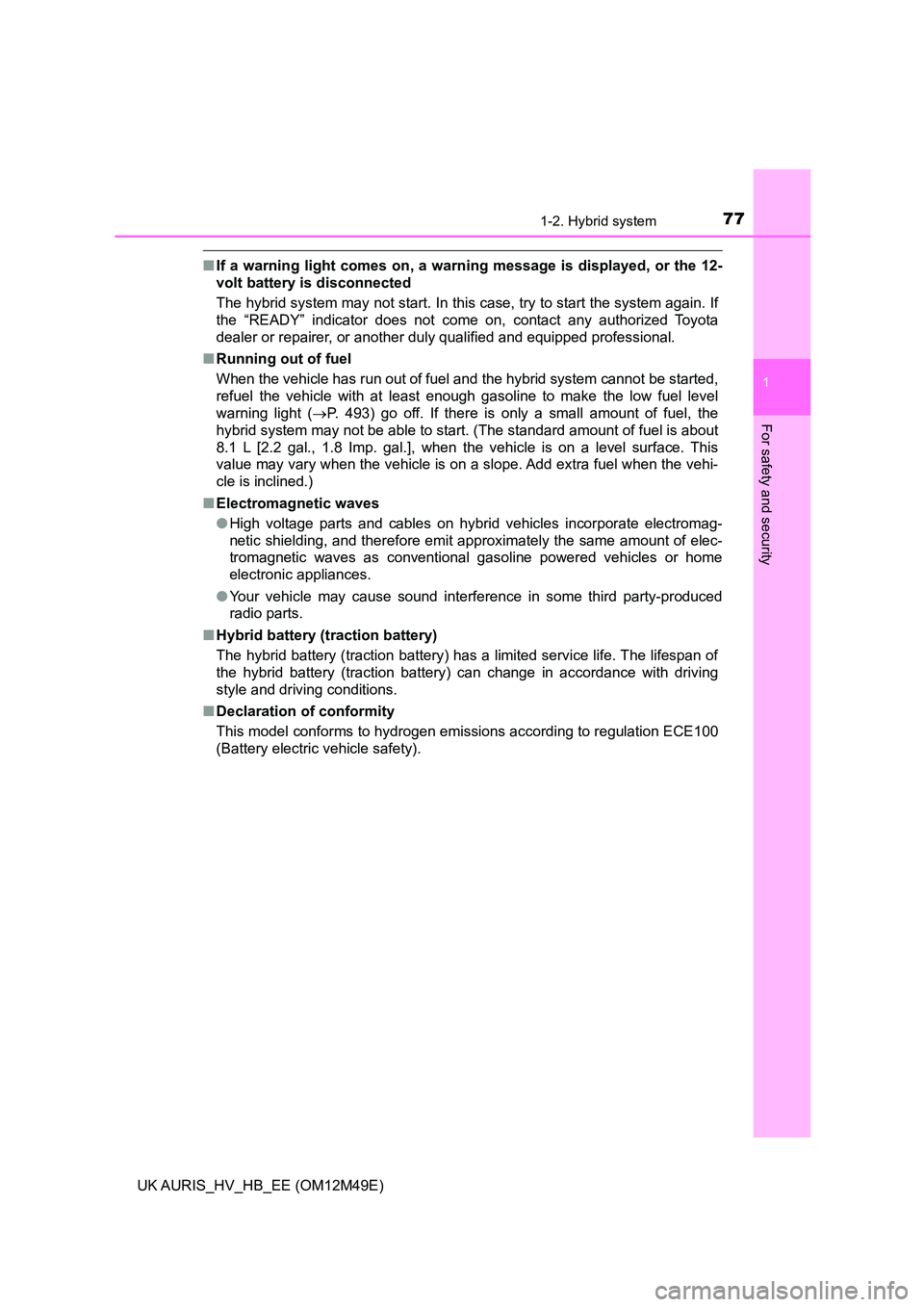
771-2. Hybrid system
1
For safety and security
UK AURIS_HV_HB_EE (OM12M49E)
■If a warning light comes on, a warning message is displayed, or the 12-
volt battery is disconnected
The hybrid system may not start. In this case, try to start the system again. If
the “READY” indicator does not come on, contact any authorized Toyota
dealer or repairer, or another duly qualified and equipped professional.
■ Running out of fuel
When the vehicle has run out of fuel and the hybrid system cannot be started,
refuel the vehicle with at least enough gasoline to make the low fuel level
warning light ( P. 493) go off. If there is only a small amount of fuel, the
hybrid system may not be able to start. (The standard amount of fuel is about
8.1 L [2.2 gal., 1.8 Imp. gal.], when the vehicle is on a level surface. This
value may vary when the vehicle is on a slope. Add extra fuel when the vehi-
cle is inclined.)
■ Electromagnetic waves
● High voltage parts and cables on hybrid vehicles incorporate electromag-
netic shielding, and therefore emit approximately the same amount of elec-
tromagnetic waves as conventional gasoline powered vehicles or home
electronic appliances.
● Your vehicle may cause sound interference in some third party-produced
radio parts.
■ Hybrid battery (traction battery)
The hybrid battery (traction battery) has a limited service life. The lifespan of
the hybrid battery (traction battery) can change in accordance with driving
style and driving conditions.
■ Declaration of conformity
This model conforms to hydrogen emissions according to regulation ECE100
(Battery electric vehicle safety).
Page 104 of 592
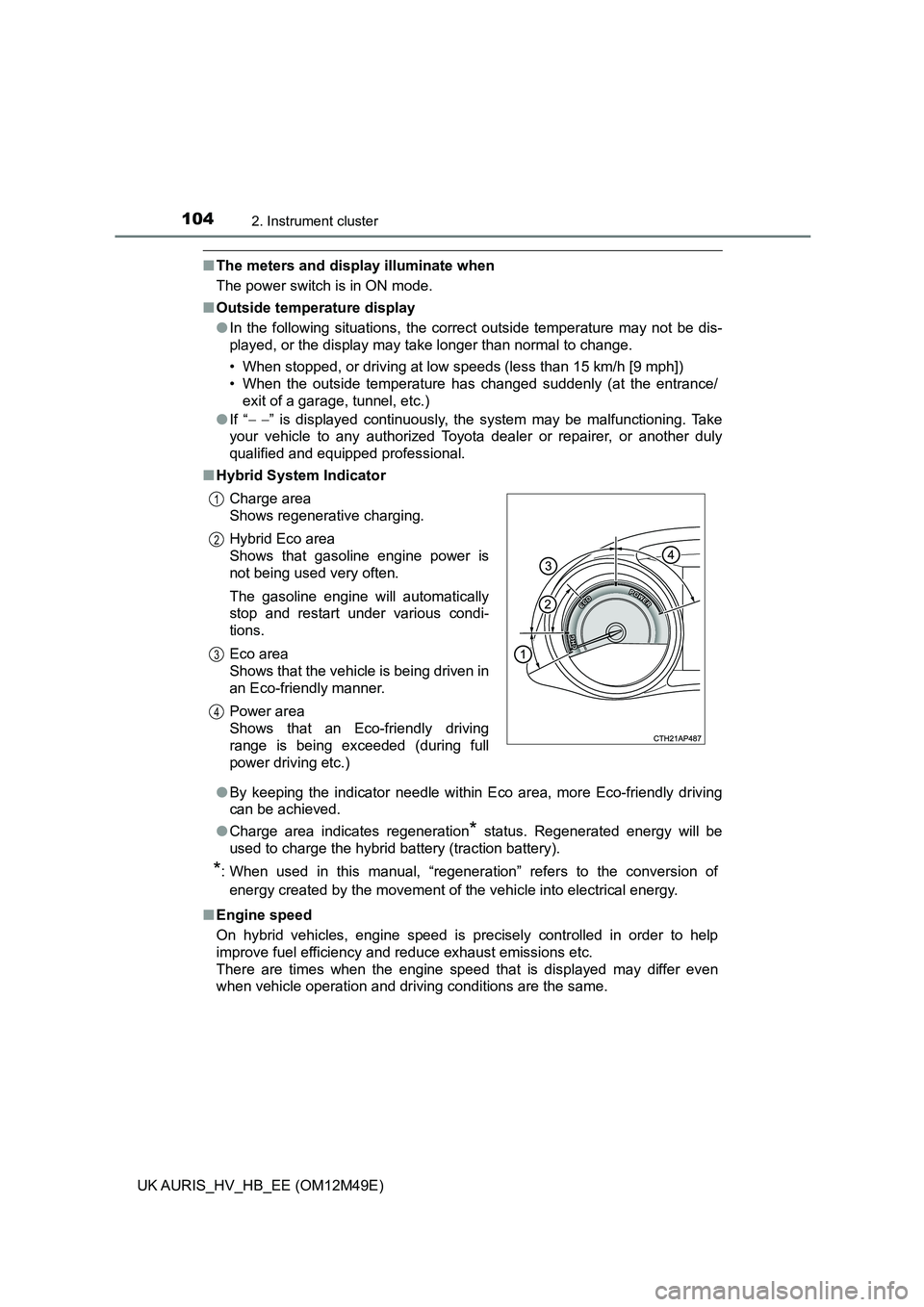
1042. Instrument cluster
UK AURIS_HV_HB_EE (OM12M49E)
■The meters and display illuminate when
The power switch is in ON mode.
■ Outside temperature display
● In the following situations, the correct outside temperature may not be dis-
played, or the display may take longer than normal to change.
• When stopped, or driving at low speeds (less than 15 km/h [9 mph])
• When the outside temperature has changed suddenly (at the entrance/
exit of a garage, tunnel, etc.)
● If “ ” is displayed continuously, the system may be malfunctioning. Take
your vehicle to any authorized Toyota dealer or repairer, or another duly
qualified and equipped professional.
■ Hybrid System Indicator
● By keeping the indicator needle within Eco area, more Eco-friendly driving
can be achieved.
● Charge area indicates regeneration* status. Regenerated energy will be
used to charge the hybrid battery (traction battery).
*: When used in this manual, “regeneration” refers to the conversion of
energy created by the movement of the vehicle into electrical energy.
■ Engine speed
On hybrid vehicles, engine speed is precisely controlled in order to help
improve fuel efficiency and reduce exhaust emissions etc.
There are times when the engine speed that is displayed may differ even
when vehicle operation and driving conditions are the same.
Charge area
Shows regenerative charging.
Hybrid Eco area
Shows that gasoline engine power is
not being used very often.
The gasoline engine will automatically
stop and restart under various condi-
tions.
Eco area
Shows that the vehicle is being driven in
an Eco-friendly manner.
Power area
Shows that an Eco-friendly driving
range is being exceeded (during full
power driving etc.)
1
2
3
4